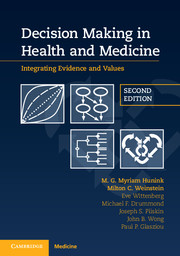Book contents
- Frontmatter
- Dedication
- Contents
- Foreword
- Foreword to the first edition (2001)
- Preface
- Acknowledgments
- list of Abbreviations
- About the authors
- 1 Elements of decision making in health care
- 2 Managing uncertainty
- 3 Choosing the best treatment
- 4 Valuing outcomes
- 5 Interpreting diagnostic information
- 6 Deciding when to test
- 7 Multiple test results
- 8 Finding and summarizing the evidence
- 9 Constrained resources
- 10 Recurring events
- 11 Estimation, calibration, and validation
- 12 Heterogeneity and uncertainty
- 13 Psychology of judgment and choice
- Index
- References
1 - Elements of decision making in health care
Published online by Cambridge University Press: 05 October 2014
- Frontmatter
- Dedication
- Contents
- Foreword
- Foreword to the first edition (2001)
- Preface
- Acknowledgments
- list of Abbreviations
- About the authors
- 1 Elements of decision making in health care
- 2 Managing uncertainty
- 3 Choosing the best treatment
- 4 Valuing outcomes
- 5 Interpreting diagnostic information
- 6 Deciding when to test
- 7 Multiple test results
- 8 Finding and summarizing the evidence
- 9 Constrained resources
- 10 Recurring events
- 11 Estimation, calibration, and validation
- 12 Heterogeneity and uncertainty
- 13 Psychology of judgment and choice
- Index
- References
Summary
And take the case of a man who is ill. I call two physicians: they differ in opinion. I am not to lie down and die between them: I must do something.
Samuel JohnsonIntroduction
How are decisions made in practice, and can we improve the process? Decisions in health care can be particularly awkward, involving a complex web of diagnostic and therapeutic uncertainties, patient preferences and values, and costs. It is not surprising that there is often considerable disagreement about the best course of action. One of the authors of this book tells the following story (1):
Being a cardiovascular radiologist, I regularly attend the vascular rounds at the University Hospital. It’s an interesting conference: the Professor of Vascular Surgery really loves academic discussions and each case gets a lot of attention. The conference goes on for hours. The clinical fellows complain, of course, and it sure keeps me from my regular work. But it’s one of the few conferences that I attend where there is a real discussion of the risks, benefits, and costs of the management options. Even patient preferences are sometimes (albeit rarely) considered.
And yet, I find there is something disturbing about the conference. The discussions always seem to go along the same lines. Doctor R. advocates treatment X because he recently read a paper that reported wonderful results; Doctor S. counters that treatment X has a substantial risk associated with it, as was shown in another paper published last year in the world’s highest-ranking journal in the field; and Doctor T. says that given the current limited health-care budget maybe we should consider a less expensive alternative or no treatment at all. They talk around in circles for ten to 15 minutes, each doctor reiterating his or her opinion. The professor, realizing that his fellows are getting irritated, finally stops the discussion. Practical chores are waiting; there are patients to be cared for. And so the professor concludes: ‘All right. We will offer the patient treatment X.’ About 30% of those involved in the decision-making process nod their heads in agreement; another 30% start bringing up objections which get stifled quickly by the fellows who really do not want an encore, and the remaining 40% are either too tired or too flabbergasted to respond, or are more concerned about another objective, namely their job security.
- Type
- Chapter
- Information
- Decision Making in Health and MedicineIntegrating Evidence and Values, pp. 1 - 28Publisher: Cambridge University PressPrint publication year: 2014
References
- 3
- Cited by



